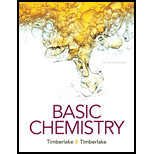
Concept explainers
Interpretation:
Determine whether a solid forms when solutions containing the following ionic compounds are mixed. IF so, write the ionic equation and net ionic equation.
a. Na3PO4(aq) and AgNO3(aq)
b. K2SO4 (aq) and Na2CO3(aq)
c. Pb(NO3)2 (aq) and Na2CO3(aq)
d. BaCl2(aq) and KOH(aq)
Concept introduction:
Ionic compounds are dissolved in water. Because they contain soluble anion and cation will dissolve in water.
Solubility rules for ionic compounds in water.
| An ionic compound is soluble in water if it contains one of the following | |
| Positive ions | Li+, Na+, K+, Rb+, Cs+ and NH4+ |
| Negative ions | |
| Cl-, Br-,I- except when combined with Ag+, Pb2+ or except when combined with Ba2+, pb2+,Ca2+,Sr2+,Sr2+ or |
|
Some ionic compounds do not have the above ions. Those are insoluble compounds.
We can also use solubility rules for solid compounds to predict the solubility.
Solutions containing soluble reactants are mixed together to form precipitate.
To write an equation for the formation of an insoluble ionic compound is as follows.
► Write the ions of the reactants.
► Write the combination of ions and determine if any are soluble.
► Write the ionic equation including any solid.
► Write the net equation.
Want to see the full answer?
Check out a sample textbook solution
Chapter 12 Solutions
Basic Chemistry (5th Edition)
 ChemistryChemistryISBN:9781305957404Author:Steven S. Zumdahl, Susan A. Zumdahl, Donald J. DeCostePublisher:Cengage Learning
ChemistryChemistryISBN:9781305957404Author:Steven S. Zumdahl, Susan A. Zumdahl, Donald J. DeCostePublisher:Cengage Learning ChemistryChemistryISBN:9781259911156Author:Raymond Chang Dr., Jason Overby ProfessorPublisher:McGraw-Hill Education
ChemistryChemistryISBN:9781259911156Author:Raymond Chang Dr., Jason Overby ProfessorPublisher:McGraw-Hill Education Principles of Instrumental AnalysisChemistryISBN:9781305577213Author:Douglas A. Skoog, F. James Holler, Stanley R. CrouchPublisher:Cengage Learning
Principles of Instrumental AnalysisChemistryISBN:9781305577213Author:Douglas A. Skoog, F. James Holler, Stanley R. CrouchPublisher:Cengage Learning Organic ChemistryChemistryISBN:9780078021558Author:Janice Gorzynski Smith Dr.Publisher:McGraw-Hill Education
Organic ChemistryChemistryISBN:9780078021558Author:Janice Gorzynski Smith Dr.Publisher:McGraw-Hill Education Chemistry: Principles and ReactionsChemistryISBN:9781305079373Author:William L. Masterton, Cecile N. HurleyPublisher:Cengage Learning
Chemistry: Principles and ReactionsChemistryISBN:9781305079373Author:William L. Masterton, Cecile N. HurleyPublisher:Cengage Learning Elementary Principles of Chemical Processes, Bind...ChemistryISBN:9781118431221Author:Richard M. Felder, Ronald W. Rousseau, Lisa G. BullardPublisher:WILEY
Elementary Principles of Chemical Processes, Bind...ChemistryISBN:9781118431221Author:Richard M. Felder, Ronald W. Rousseau, Lisa G. BullardPublisher:WILEY





